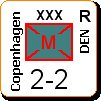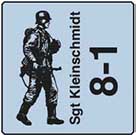Shannon V. OKeets
Posts: 22095
Joined: 5/19/2005
From: Honolulu, Hawaii
Status: offline

|
quote:
ORIGINAL: Extraneous
quote:
ORIGINAL: Shannon V. OKeets
I have been going crazy the past couple of days trying to remember what the Germans called their units that got cut off during the Russian winter offensive 1941-1942. Hitler labeled it a tactic and insisted on it being used throughout the long retreat from Stalingrad.
I assume that virtually all of you know the answer to this (even some remote part of my brain does I am sure).
Thay were called "Strong points".
Example: Originally Rommel confided that the invasion could occur as early as late-May and he remarked to the assembled garrison at strong point Wn.62 that “this section of the coast resembles the Bay of Salerno in Italy and there fore we should be on special guard against hostile landings!” Allied troops landed in the Bay of Salerno in September 1943. -SB
The 352nd Infantry Division at Omaha Beach
A company, along with C company of the 1st Battalion South Lancs, would attack and eliminate the Strong Point Cod. This consisted of: One 75mm gun, two 50mm anti-tank guns, three 81mm mortars, a 37mm gun and 5 machine gun posts.
East Yorkshire Regiment Living History Group
By late 1944, the German position on both the Eastern and Western Fronts was steadily crumbling. On June 22, 1944 (the third anniversary of the German invasion of Russia), the Russians broke through two strong points in the German line and surrounded 40 divisions known as Army Group Center.
FC136: World War II in Europe (1939-45)
Could you be thinking of Kampfgruppe?
A combat formation of any kind, but most usually to that employed by the German Wehrmacht and its allies during World War II and, to a lesser extent, in World War I.
Hedgehog was the term I was trying to remember.
This is for the AI Opponenet nomenclature.
When contesting a Land Region, hex control and the presence of friendly and enemy units can be assessed as:
1 - Theirs: enemy controls all hexes in the LR.
2 - Cleanup: no enemy units present in the LR but some hexes are enemy controlled.
3 - Consolidate: isolated enemy units present in the LR.
4 - Eliminate: enemy has a bridgehead in the LR.
5 - Conflict: both sides have units in the LR.
6 - Bridgehead: 'we' have a bridgehead in the LR.
7 - Hedgehog: 'we' have isolated units in the LR.
8 - Partisans: 'we' have no units present, but still control some hexes.
9 - Ours: we control all hexes in the LR.
It's possible that there might be a mix of some of these. For instance, in advancing into Eastern Poland, there could be a mix or 2/3/4.
There is also the relationship of adjacent LRs to take into consideration. At the start of the war, Germany would have a status of Ours in Germany and Theirs in Poland.
But for now, I just wanted to establish a quasi scale for the AIO tactical decision making.
[I apologize for this being off-topic. If you want to continue this discussion, please use one of the thread on the AIO, or start a new thread.]
_____________________________
Steve
Perfection is an elusive goal.
|
 Printable Version
Printable Version








 USS Tang is correct though it is the better known of the two because of her famous commander. Any idea on the other?
USS Tang is correct though it is the better known of the two because of her famous commander. Any idea on the other? 










 New Messages
New Messages No New Messages
No New Messages Hot Topic w/ New Messages
Hot Topic w/ New Messages Hot Topic w/o New Messages
Hot Topic w/o New Messages Locked w/ New Messages
Locked w/ New Messages Locked w/o New Messages
Locked w/o New Messages Post New Thread
Post New Thread